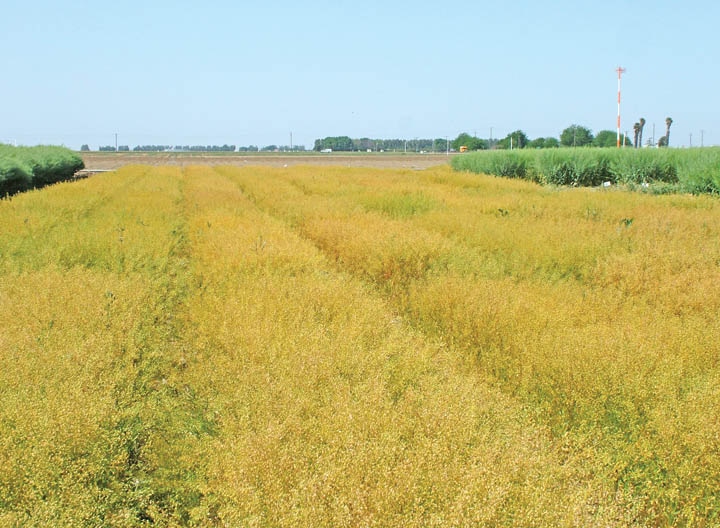October 17, 2012

Camelina and canola seem to be the frontrunners in the race to find new biofuel feedstock crops for California.
University of California agronomist Steve Kaffka has several years of trials on these crops, including three consecutive years of comparison trials at Davis, Calif., and Five Points, Calif., at the Westside Research and Extension Center (WREC), where he updated his work for an agronomy day.
Yields are higher at Five Points than at Davis, but it may take more water to grow the crops in the Central San Joaquin Valley than at Davis, where there is more rainfall.
The key to economic success with these crops is oil yield.
“You need 150 to 200 gallons of oil per acre to be successful” in California cropping systems, he says.
Canola achieved that in 2010 trials at Davis and Five Points, Kaffka said at the WREC field day. Canola yielded 2,563 pounds per acre in Davis that year and almost 3,400 pounds at WREC. Oil yields then were 163 and 190 respectively.
However, it has been a struggle to achieve those yields the past two seasons. In 2011 the yield at Davis was only 748 pounds per acre and just 50 gallons of oil and 2,004 pounds per acre and just 113 gallons of oil per acre at WREC. Kaffka attributes the low yields to a cold, wet spring that season.
This season, it was a disaster at WREC with a yield of just 890 pounds per acre. He does not have oil yield yet. He attributed the disastrous yield to herbicide drift injury. At Davis the canola yielded 2,290 pounds per acre.
Camelina did not fare nearly as well compared to Canola any season. The yields ranged from 2,015 pounds per acre at WREC in 2010 to a low of just 254 pounds there this season. Davis yields have been 970 and 591 pounds per acre for the past two seasons. The oil yield reached 100 gallons per acre only with the 2010 camelina yields at WREC.
Camelina is a low water and nitrogen user, Kaffka says, needing only about 60 to 80 pounds of N per acre. It requires 13 to 18 inches of water, which means in many areas of the state it could be produced on winter rainfall alone. In other areas like the central and southern San Joaquin valley, it likely would require one supplemental irrigation with normal average winter rainfall.
Australian success
Kaffka has learned that seeding rates and plant populations are critical. Crusting and emergence were issues in a Shafter, Calif., trial with shatter a problem at WREC. Weed control would be an issue in commercial production, since there are no registered herbicides. Canola has similar N requirement as camelina.
Australian Nic George, a UC associate specialist, worked with canola in Western Australia and is involved with the California biofuel crop work.
Australian growers have been producing canola for oil for 20 years under conditions similar to California’s central valley and “really like it,” he says.
He believes the Australian varieties hold a yield potential of 3,000 pounds per acre for the northern and central valleys of California.
Camelina and canola will compete with cereal grains and that would be a tough fight this year against the high price of wheat.
All of this work is being propelled by growing state and federal mandates to replace fossil fuels. EPA has set a target for the U.S. to produce 36 billion gallons of biofuel by 2022.
About the Author(s)
You May Also Like






